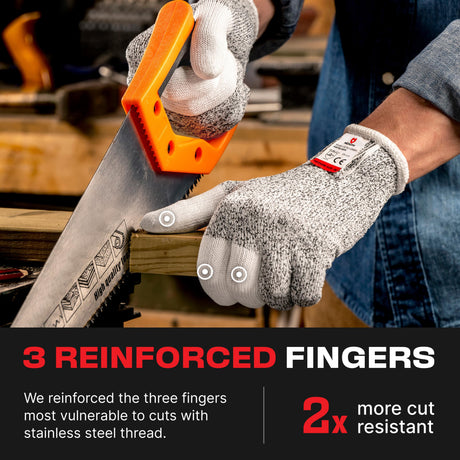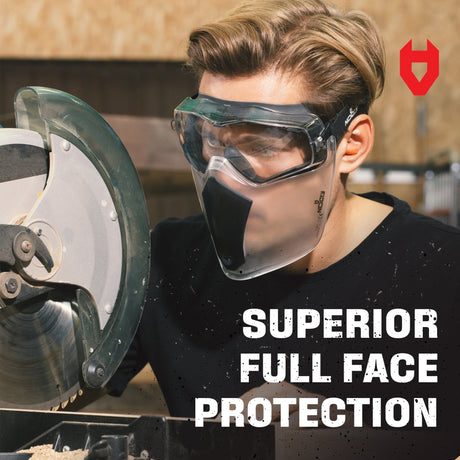Contents
Key Takeaways
- Budgets vary by home size and scope — expect 10–20% over your estimate.
- DIY is possible for certain tasks, but know your limits.
- Plan for temporary housing if your home’s not livable during renovation.
- Personal protective equipment (PPE) is your first line of defense — always wear the right gear for the job.
- Test older homes for lead, asbestos, or other hazardous materials before disturbing surfaces.
- Turn off power and water before starting electrical or plumbing work, and confirm they’re off.
- Prevent fire risks by storing tools and flammables safely and keeping a fire extinguisher nearby.
- Clear the workspace, use tools correctly, and keep kids and pets far away from the job zone.
What Does It Mean to Renovate a Home?
Renovating a home means updating, repairing, or improving parts of your house without changing its basic structure. The goal is to make the space more functional, modern, or comfortable, whether that’s replacing old flooring, updating a kitchen, or fixing wear and tear over time.
Unlike remodeling (which might involve changing layouts or moving walls), renovation keeps the original layout and focuses on restoring or upgrading what’s already there. It can be as simple as repainting walls and installing new light fixtures, or as involved as redoing the bathrooms and installing new windows.
Renovation is a great way to extend the life of your home, increase its value, and make it better fit your needs, all without starting from scratch.
How Should You Prepare for Renovating Your Home?
Preparing for a home renovation is just as important as the work itself. Start by making a clear plan: walk through your space, take notes on what needs fixing or upgrading, and set priorities. Then, create a realistic budget and timeline, making sure to include a buffer (usually 10–20%) for unexpected costs.
Next, decide if you’ll hire professionals or do some of the work yourself. Get quotes, check references, and make sure any contractors are licensed and insured. If permits are required, apply early; they can delay your project if overlooked.
It’s also smart to prep your space. Declutter and move furniture, cover floors, and seal off rooms to minimize dust. If the renovation will take weeks, you might need a temporary living plan — especially if it affects your kitchen or bathrooms.
Good prep saves you stress, time, and money once the renovation begins.

Why Is PPE Important During Home Renovations?
Personal protective equipment (PPE) protects you from the most common renovation injuries. Whether cutting, sanding, painting, or tearing down drywall, you’re exposed to dust, chemicals, flying debris, and sharp objects. Wearing the right gear isn’t just smart; it’s essential.
A basic PPE setup should include:
- Safety goggles or glasses to protect your eyes from dust and debris
- Heavy-duty gloves for handling wood, tools, or sharp materials
- Knee pads when kneeling often or for a long time
- A dust mask or respirator to protect your lungs from particles and fumes
- Steel-toed boots if you’re doing demolition or heavy lifting
- Hearing protection when using loud tools like saws or nail guns
- Long sleeves and pants to protect your skin from cuts and chemicals
If you’re dealing with insulation, mold, or anything airborne, a respirator with the right filter is better than a standard dust mask.
How Should You Prepare the Space Before Starting?
Before you pick up a hammer, take time to set up your space safely:
- Clear the area: Remove rugs, furniture, and anything that could trip you up.
- Check the airflow: Open windows and use fans to help move dust and fumes out.
- Keep tools organized: Store them in a central place where they won’t cause clutter.
-
Mark off work zones: Use tape, plastic sheeting, or signs to keep others out.
Good preparation reduces distractions and accidents. A clean, organized space lets you move freely and spot problems early — like a loose wire or a leak.
What Kind of Hazards Should You Expect During a Home Renovation?
Home renovations involve a mix of physical, chemical, and electrical hazards, and they can be easy to overlook until something goes wrong.
Watch out for:
- Sharp tools and blades (even hand tools can cut you if you’re not paying attention)
- Flying debris during demolition or cutting
- Dust and fumes from sanding, painting, or adhesives
- Mold, asbestos, or lead in older homes
- Power tools that can kick back or jam
- Hot surfaces or sparks from saws or heat tools
- Slip and trip hazards from cords, debris, or spilled liquids
That’s why PPE isn’t optional — it’s your backup when something goes sideways.
How Do You Avoid Electrical or Plumbing Accidents?
Before you touch a wall, shut off the power at the breaker box. Then, test it with a voltage tester just to be safe. It’s never enough to flip the switch — live wires can still surprise you.
For plumbing:
- Turn off the main water supply
- Open taps to drain any remaining water
- Watch out for water lines when drilling into walls or floors
If you touch anything gas-related (like a stove or water heater), shut off the gas and call a pro. Gas leaks can build up quickly and are hard to detect until too late.

How Can You Prevent Fire Risks During Renovation?
Fire is one of the most overlooked dangers during home projects. Between power tools, exposed wires, and flammable materials, you’ve got the perfect setup for an accident if you’re not careful.
To reduce risk:
- Unplug tools when not in use
- Never leave heat tools or lights running unattended
- Keep oily rags, paint cans, and solvents away from heat sources
- Store flammables in closed containers, preferably outdoors
- Keep a fire extinguisher nearby and know how to use it
Also, check that your smoke alarms are working — especially in or near the renovated rooms.
Should You Be Worried About Hazardous Materials?
Yes. If your home was built before the 1990s, there’s a real chance it could contain lead-based paint or asbestos in insulation, floor tiles, or old ceilings. You can’t see or smell these materials; disturbing them spreads harmful particles into the air.
The safest move:
- Have your home tested before you scrape, sand, or tear out walls
- If lead or asbestos is present, hire a certified professional for removal
- Wear a fitted respirator and use plastic sheeting to seal off rooms if you’re doing any work near potential hazards
Is It Safe to Renovate When Kids or Pets Are in the House?
Short answer: not really — at least not while the work is active. Construction zones are full of risks for curious little hands and paws. Sharp tools, exposed wires, and loose nails are just the start.
To stay safe:
- Keep kids and pets out of the workspace at all times
- Use gates or barriers to block off rooms under renovation
- Store tools high or in locked cabinets when not in use
- Vacuum and clean thoroughly at the end of each workday
Even after work is done, leftover dust or fumes can linger. Always air out the space before letting anyone back in.
What Safety Tips Should You Follow DIY During Home Renovations?
Doing it yourself can save money, but DIY home renovation comes with risks — mainly if you’re not used to power tools, ladders, or demolition work. Here’s how to stay safe:
- Know your limits: Don’t take on complex electrical or structural work unless trained. Some jobs do require a pro.
- Take your time: Rushing leads to mistakes. Plan your steps, and don’t work when you’re tired or distracted.
- Read instructions: Before using a power tool, chemical product, or bag of cement, read the label or manual.
- Use the correct PPE: Even for “quick” jobs, wear safety glasses, gloves, and a mask. You never know when something might go wrong.
- Keep tools in top shape: Dull blades or frayed cords are more likely to cause accidents. Always inspect your tools before each use.
- Clean as you go: A messy workspace can cause trips, slips, or fire hazards. Keep your area clean, and dispose of debris daily.
- Let someone know: If you’re working alone, tell someone what you’re doing and check in if something happens.
DIY can be satisfying, but safety has to come first. No project is worth a trip to the ER.
What’s the Right Order to Renovate a House Without Wasting Time or Money?
Renovating a house isn’t just about picking paint colors or choosing tiles. Getting the order right is the difference between a smooth project and one that constantly runs into delays and extra costs. The best approach is to start from the ground up, literally.
Start by fixing anything related to the structure and safety of the home. That includes the foundation, roof, and any major water damage or termite issues. Once the bones of the house are solid, move on to systems like electrical, plumbing, and HVAC. These are crucial to get right before you seal up walls or add finishes.
After that, focus on insulation, drywall, and windows. Only once the basic systems and structures are in place should you move on to cosmetic upgrades like flooring, cabinets, paint, and fixtures. Doing things in this order ensures you’re not undoing finished work later because something behind the walls needs fixing.
Tip: Use plastic sheeting, drop cloths, and painter’s tape to keep dust from spreading and surfaces from getting damaged.
How Much Should You Really Budget for a Home Renovation Project?
Home renovation costs vary a lot based on location, house size, and how much you’re changing. That said, a realistic average is $15 to $60 per square foot. So, renovating a 2,000-square-foot home could run you anywhere from $30,000 to over $120,000, depending on what’s involved.
A basic update, such as new paint, flooring, and fixtures, can often be done on the lower end of the range. But if you’re tearing out a kitchen or moving walls, costs jump fast. Labor and permits also add up. It’s smart to set aside 10–20% extra in your budget for surprises, which always come up, especially in older homes.
If you’re not sure where to start, walk through your home and list what’s needed, then get multiple quotes. Prioritize essentials first. Budgeting realistically helps you avoid stopping mid-project or ending up with half-finished rooms.

Which Types of Home Remodels Actually Add the Most Resale Value?
If you’re renovating with resale in mind, you want to focus on changes that buyers care most about. At the top of the list are kitchens and bathrooms. These spaces are the most used and the most scrutinized, and even modest updates here often give a strong return on investment.
Upgrading cabinets, countertops, and appliances in the kitchen can significantly raise your home’s value. Bathroom improvements, like replacing old tile or installing a modern vanity, are also a safe bet. Next in line are curb appeal projects, like new siding, paint, or landscaping, which make a strong first impression.
Adding usable living space, such as finishing a basement or converting an attic, can also be worth it. These projects cost more but can increase square footage, something buyers are willing to pay for. Always consider your neighborhood, too. Over-improving beyond local standards doesn’t always pay off.
Can You Really Renovate a House on Your Own?
It depends. Some parts of a renovation are totally doable if you’re willing to learn and put in the time. Painting, minor demolition, laying down vinyl flooring, and installing fixtures are all tasks that many homeowners handle themselves.
But bigger jobs, like plumbing, electrical, or anything involving structural changes, should be left to licensed professionals. Not only is it safer, but you’ll also avoid issues with building codes and permits. Even if you’re confident in your skills, doing everything yourself can extend the project timeline dramatically.
If you’re on a tight budget, consider a hybrid approach: handle the simpler tasks and hire pros for the rest. That way, you can save money without putting your safety, or your home, at risk. The key is knowing your limits and when to call for help.
Conclusion
Renovating your home can be exciting, but it takes more than just picking paint colors to do it right. Safety should always come first: wear the proper PPE, keep your work area clean, and don’t skip prep work. Just as important is having a solid plan, such as setting a realistic budget (with a buffer for surprises), choosing whether to DIY or hire help, and mapping out a timeline that works for your household.
Whether you're refreshing a single room or tackling a full remodel, taking time to protect yourself, your family, and your space makes the whole process smoother, safer, and a lot less stressful.
FAQ
Should I take the DIY route or hire a contractor for my renovation?
Deciding between DIY or hiring a contractor depends on your skills, the project size, and your time. Simple jobs like painting or tiling are great for DIY. But anything involving permits, structure, or utilities is safer left to the pros. Contractors also work faster and offer warranties. For many, a mix of DIY and professional help strikes the right balance.
What is the most essential safety gear for home renovation?
Start with goggles, gloves, and a dust mask or respirator. If you use power tools or work around debris, add steel-toed boots and hearing protection.
What is the 30% rule for renovations?
The 30% rule says you shouldn’t spend more than 30% of your home’s value on renovations. So if your house is worth $400,000, your total budget should stay under $120,000. This helps you avoid overinvesting in upgrades you won’t get back when you sell.
What is the most expensive part of remodeling a house?
Kitchens and bathrooms are the priciest areas because of the plumbing, cabinetry, tile, and appliances involved. Structural changes and permits also drive up costs. If you’re moving walls or reconfiguring layouts, expect to pay more.
Do renovations increase property taxes?
They can. If your renovation raises the home’s assessed value, your property taxes may go up. Major improvements like adding square footage or upgrading kitchens and baths are most likely to trigger reassessments. Check with your local tax authority to be sure.
How long does a full home renovation take?
It varies, but a full renovation often takes 4 to 12 months. Small updates might only take a few weeks, but major remodels (especially those needing permits or inspections) can stretch out longer, especially if you run into delays or backorders.
Where do I stay when my house is being renovated?
If you’re doing a major renovation, especially one affecting the kitchen, bathroom, or all living spaces, it’s best to stay elsewhere. You can go to a hotel, crash with family, or find short-term housing. Some people live in one part of the house while the other is under construction.
What are some eco-friendly home renovation ideas?
Eco-friendly renovations can cut energy use and waste while making your home more comfortable. Try energy-efficient windows, low-flow plumbing, and LED lighting. Use sustainable materials like bamboo or reclaimed wood, and consider solar panels if your budget allows. Even small changes like non-toxic paint help reduce your footprint.



























